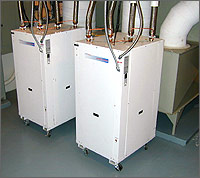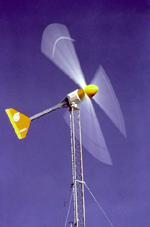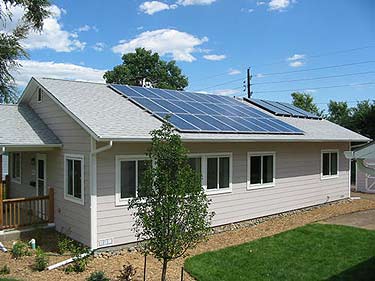Copyright � 2009 YouSaveGreen LLC � All Rights reserved �

� 2010 MRBS Inc. All rights reserved.
Solar Energy
Solar-electricity, or photovoltaics (PV) converts sunlight directly into electricity. You may be more familiar with PV cells as solar cells that power watches and calculators. But PV can do much more. It can provide electricity for residential and commercial buildings, including power for lights and air conditioning. PV can also be a convenient source of power for pumping water, electrifying fences, or aerating ponds in remote applications.
As an energy-conscious consumer, you want to do all you can to use energy efficiently and add more clean, renewable energy to your life. This section contains information and analysis tools to help you evaluate your options and make an informed decision. If you've already decided to install solar electric panels (also called photovoltaic or PV panels) on your roof, you've given it careful thought and considered all the benefits of using a reliable, abundant, and environmentally smart source of energy � the sun. If you haven't decided yet, we hope the information in these pages will help you make a decision about purchasing PV panels for your home or business
Wind Energy
Wind is created by the unequal heating of the Earth's surface by the sun. Wind turbines convert the kinetic energy in wind into clean electricity.
When the wind spins the wind turbine's blades, a rotor captures the kinetic energy of the wind and converts it into rotary motion to drive the generator. The manufacturer can provide information on the maximum wind speed at which the turbine is designed to operate safely. Most turbines have automatic overspeed-governing systems to keep the rotor from spinning out of control in very high winds.
Geothermal Heating/Cooling
The geothermal heat pump, also known as the ground source heat pump, is a highly efficient renewable energy technology that is gaining wide acceptance for both residential and commercial buildings. Geothermal heat pumps are used for space heating and cooling, as well as water heating. Its great advantage is that it works by concentrating naturally existing heat, rather than by producing heat through combustion of fossil fuels.
The technology relies on the fact that the Earth (beneath the surface) remains at a relatively constant temperature throughout the year, warmer than the air above it during the winter and cooler in the summer, very much like a cave. The geothermal heat pump takes advantage of this by transferring heat stored in the Earth or in ground water into a building during the winter, and transferring it out of the building and back into the ground during the summer. The ground, in other words, acts as a heat source in winter and a heat sink in summer.
The system includes three principal components:
Geothermal earth connection subsystem
Geothermal heat pump subsystem
Geothermal heat distribution subsystem.
(Source DOE website)
Rain Water Collection
Looking for the freedom of a large capacity rain barrel but don't want to take up precious yard space? Our underground rain water catching systems can be the answer. By diverting the water from all of your downspouts into a one of our large capacity rain underground rain savers you can be sure to maximize your roofs harvesting potential. With some planning beforehand you can have a rain water collection system that significantly lowers your monthly water bill and yet is almost invisible to your neighbors. Each of our underground units have built in sump pumps to allow for easy plumbing.
Solar-electricity, or photovoltaics (PV) converts sunlight directly into electricity. You may be more familiar with PV cells as solar cells that power watches and calculators. But PV can do much more. It can provide electricity for residential and commercial buildings, including power for lights and air conditioning. PV can also be a convenient source of power for pumping water, electrifying fences, or aerating ponds in remote applications.
As an energy-conscious consumer, you want to do all you can to use energy efficiently and add more clean, renewable energy to your life. This section contains information and analysis tools to help you evaluate your options and make an informed decision. If you've already decided to install solar electric panels (also called photovoltaic or PV panels) on your roof, you've given it careful thought and considered all the benefits of using a reliable, abundant, and environmentally smart source of energy � the sun. If you haven't decided yet, we hope the information in these pages will help you make a decision about purchasing PV panels for your home or business
Wind Energy
Wind is created by the unequal heating of the Earth's surface by the sun. Wind turbines convert the kinetic energy in wind into clean electricity.
When the wind spins the wind turbine's blades, a rotor captures the kinetic energy of the wind and converts it into rotary motion to drive the generator. The manufacturer can provide information on the maximum wind speed at which the turbine is designed to operate safely. Most turbines have automatic overspeed-governing systems to keep the rotor from spinning out of control in very high winds.
Geothermal Heating/Cooling
The geothermal heat pump, also known as the ground source heat pump, is a highly efficient renewable energy technology that is gaining wide acceptance for both residential and commercial buildings. Geothermal heat pumps are used for space heating and cooling, as well as water heating. Its great advantage is that it works by concentrating naturally existing heat, rather than by producing heat through combustion of fossil fuels.
The technology relies on the fact that the Earth (beneath the surface) remains at a relatively constant temperature throughout the year, warmer than the air above it during the winter and cooler in the summer, very much like a cave. The geothermal heat pump takes advantage of this by transferring heat stored in the Earth or in ground water into a building during the winter, and transferring it out of the building and back into the ground during the summer. The ground, in other words, acts as a heat source in winter and a heat sink in summer.
The system includes three principal components:
Geothermal earth connection subsystem
Geothermal heat pump subsystem
Geothermal heat distribution subsystem.
(Source DOE website)
Rain Water Collection
Looking for the freedom of a large capacity rain barrel but don't want to take up precious yard space? Our underground rain water catching systems can be the answer. By diverting the water from all of your downspouts into a one of our large capacity rain underground rain savers you can be sure to maximize your roofs harvesting potential. With some planning beforehand you can have a rain water collection system that significantly lowers your monthly water bill and yet is almost invisible to your neighbors. Each of our underground units have built in sump pumps to allow for easy plumbing.





"We Are Rebuilding Communities One Student, and One House at a Time"
To Learn More Call 1-888-907-6727